Ground Penetrating Radar as a Functional Tool to Outline the Presence of Buried Waste: A Case Study in South Italy
Abstract
:1. Introduction
Theoretical Framework and Principles of GPR (Ground Penetrating Radar)
2. Materials and Methods
2.1. Study Area and Local Geology
2.1.1. Data Acquisition
- (a)
- raw data;
- (b)
- processed data with identification through an analysis of the noise and signal loss maximum effective penetration;
- (c)
- identification and interpretation of the anomalies.
2.1.2. Data Processing
- elevation correction is necessary to vertically adjust the whole profile’s position in the data window (adjust time-zero). A corrected 0-position gave a better depth calculation as it sets the top of the scan to a more accurate approximation of the ground surface;
- Infinite impulse response (IIR) application with an IIR Vertical High Pass Filter with a cut-off frequency corresponding to about 1⁄4 of the antenna’s center frequency. Using a 400 MHz antenna, we set the high pass cut to 80 MHz as a starting point that gave us the best fit; and
- application of range gain option set to four points (the number of sections the data is divided equally vertically); gain corrections are applied to the entire dataset, where the best curve created will amplify the low amplitude signal and the high amplitude areas.
2.1.3. RDP (Relative Dielectric Permittivity) Estimation
3. Results and Discussion
4. Conclusions
Author Contributions
Funding
Data Availability Statement
Acknowledgments
Conflicts of Interest
References
- Pierce, D.; DeReamer, J. Geophysical Investigation For Buried Drums: A Case Study; EAGE Publications: London, UK, 1993; pp. 229–244. [Google Scholar]
- Foley, E.J. Stols™ Magnetic Survey At Sandia National Laboratory Technical Area 2; EAGE Publications: London, UK, 1994; pp. 895–907. [Google Scholar]
- Vogelsang, D. Environmental Geophysics—A Practical Guide|Dieter Vogelsang ; Springer: Berlin/Heidelberg, Germany, 1995; Available online: https://www.springer.com/gp/book/9783642851438 (accessed on 19 February 2021).
- Gibson, P.J.; Lyle, P.; George, D.M. Environmental applications of magnetometry profiling. Environ. Geol. 1996, 27, 178–183. [Google Scholar] [CrossRef]
- Marchetti, M.; Marchetti, M.; Chiappini, M.; Meloni, A. A test site for the magnetic detection of buried steel drums. Ann. Geophys. 1998, 41. [Google Scholar] [CrossRef]
- Tsourlos, P.; Vargemezis, G.N.; Fikos, I.; Tsokas, G.N. DC geoelectrical methods applied to landfill investigation: Case studies from Greece. First Break 2014, 32, 81–89. [Google Scholar] [CrossRef]
- Ntarlagiannis, D.; Robinson, J.; Soupios, P.; Slater, L. Field-scale electrical geophysics over an olive oil mill waste deposition site: Evaluating the information content of resistivity versus induced polarization (IP) images for delineating the spatial extent of organic contamination. J. Appl. Geophys. 2016, 135, 418–426. [Google Scholar] [CrossRef]
- Iwalewa, T.M.; Makkawi, M.H. Site characterization and risk assessment in support of the design of groundwater remediation well near a hazardous landfill. Arab. J. Geosci. 2015, 8, 1705–1715. [Google Scholar] [CrossRef]
- Soupios, P.; Ntarlagiannis, D. Characterization and monitoring of solid waste disposal sites using geophysical methods: Current applications and novel trends. In Modelling Trends in Solid and Hazardous Waste Management; Springer: Singapore, 2017; pp. 75–103. ISBN 9789811024108. [Google Scholar]
- Pazzi, V.; Morelli, S.; Fanti, R. A Review of the Advantages and Limitations of Geophysical Investigations in Landslide Studies. J. Geophys. 2019. [Google Scholar] [CrossRef] [Green Version]
- Conyers, L.B. Ground-penetrating Radar for Archaeological Mapping. In Remote Sensing in Archaeology; Springer: New York, NY, USA, 2007; pp. 329–344. [Google Scholar]
- Gueting, N.; Vienken, T.; Klotzsche, A.; van der Kruk, J.; Vanderborght, J.; Caers, J.; Vereecken, H.; Englert, A. High resolution aquifer characterization using crosshole GPR full-waveform tomography: Comparison with direct-push and tracer test data. Water Resour. Res. 2017, 53, 49–72. [Google Scholar] [CrossRef]
- Binley, A.; Hubbard, S.S.; Huisman, J.A.; Revil, A.; Robinson, D.A.; Singha, K.; Slater, L.D. The emergence of hydrogeophysics for improved understanding of subsurface processes over multiple scales. Water Resour. Res. 2015, 51, 3837–3866. [Google Scholar] [CrossRef] [Green Version]
- Soupios, P.; Kokinou, E. Geophysics: Principles, Applications and Emerging Technologies; Aiello, G., Ed.; Nova Publisher: Hauppauge, NY, USA, 2017. [Google Scholar]
- Chen, C.; Zhang, J. A Review on GPR Applications in Moisture Content Determination and Pavement Condition Assessment; American Society of Civil Engineers (ASCE): Reston, VA, USA, 2009; pp. 138–143. [Google Scholar]
- Slater, L.; Comas, X. The contribution of ground penetrating radar to water resource research. In Ground Penetrating Radar; Elsevier: Amsterdam, The Netherlands, 2009; pp. 203–246. ISBN 9780444533487. [Google Scholar]
- Redman, D. Contaminant mapping. In Ground Penetrating Radar; Elsevier: Amsterdam, The Netherlands, 2009; pp. 247–269. ISBN 9780444533487. [Google Scholar]
- Wu, T.-N.; Huang, Y.-C. Detection of Illegal Dump Deposit with GPR: Case Study. Pract. Period. Hazard. Toxic Radioact. Waste Manag. 2006, 10, 144–149. [Google Scholar] [CrossRef] [Green Version]
- Gosar, A. Analysis of the capabilities of low frequency ground penetrating radar for cavities detection in rough terrain conditions: The case of Divača cave, Slovenia. Acta Carsologica 2012, 41, 77–88. [Google Scholar] [CrossRef]
- Leckebusch, J. Use of antenna arrays for GPR surveying in archaeology. Near Surf. Geophys. 2005, 3, 111–115. [Google Scholar] [CrossRef]
- Francese, R.G.; Finzi, E.; Morelli, G. 3-D high-resolution multi-channel radar investigation of a Roman village in Northern Italy. J. Appl. Geophys. 2009, 67, 44–51. [Google Scholar] [CrossRef]
- Trinks, I.; Johansson, B.; Gustafsson, J.; Emilsson, J.; Friborg, J.; Gustafsson, C.; Nissen, J.; Hinterleitner, A. Efficient, large-scale archaeological prospection using a true three-dimensional ground-penetrating Radar Array system. Archaeol. Prospect. 2010, 17, 175–186. [Google Scholar] [CrossRef]
- Trinks, I.; Hinterleitner, A.; Neubauer, W.; Nau, E.; Löcker, K.; Wallner, M.; Gabler, M.; Filzwieser, R.; Wilding, J.; Schiel, H.; et al. Large-area high-resolution ground-penetrating radar measurements for archaeological prospection. Archaeol. Prospect. 2018, 25, 171–195. [Google Scholar] [CrossRef]
- Yannah, M.; Martens, K.; Van Camp, M.; Walraevens, K. Geophysical exploration of an old dumpsite in the perspective of enhanced landfill mining in Kermt area, Belgium. Bull. Eng. Geol. Environ. 2019, 78, 55–67. [Google Scholar] [CrossRef]
- Nuzzo, L.; Nuzzo, L.; Leucci, G.; Negri, S.; Carrozzo, M.T.; Quarta, T. Application of 3D visualization techniques in the analysis of GPR data for archaeology. Ann. Geophys. 2002, 45. [Google Scholar] [CrossRef]
- Ernenwein, E.G.; Kvamme, K.L. Data processing issues in large-area GPR surveys: Correcting trace misalignments, edge discontinuities and striping. Archaeol. Prospect. 2008, 15, 133–149. [Google Scholar] [CrossRef]
- Goodman, D.; Piro, S. GPR Remote Sensing in Archaeology; Springer: Berlin/Heidelberg, Germany, 2013; ISBN 9783642318573. [Google Scholar]
- Daniels, D.J. Surface-Penetrating Radar; Print; Institution of Electrical Engineers: London, UK, 1996; ISBN 0852968620. [Google Scholar]
- Orlando, L.; Marchesi, E. Georadar as a tool to identify and characterise solid waste dump deposits. J. Appl. Geophys. 2001, 48, 163–174. [Google Scholar] [CrossRef]
- Ruffell, A.; Kulessa, B. Application of Geophysical Techniques in Identifying Illegally Buried Toxic Waste. Environ. Forensics 2009, 10, 196–207. [Google Scholar] [CrossRef]
- Porsani, J.L.; Filho, W.M.; Elis, V.R.; Shimeles, F.; Dourado, J.C.; Moura, H.P. The use of GPR and VES in delineating a contamination plume in a landfill site: A case study in SE Brazil. J. Appl. Geophys. 2004, 55, 199–209. [Google Scholar] [CrossRef]
- Jiang, Y.; LI, Y.; Kang, X.; Zhou, Q.; Zhou, X.; Zhu, Y. Characteristics of Leakage Pollution of Longpan Road Gas Station and Its Enlightenment. J. Environ. Prot. 2012, 3, 49–54. [Google Scholar] [CrossRef] [Green Version]
- Davis, J.L.; Annan, A.P. Ground-penetrating radar for high-resolution mapping of soil and rock stratigraphy. Geophys. Prospect. 1989, 37, 531–551. [Google Scholar] [CrossRef]
- Ukaegbu, I.K. Nonintrusive Depth Estimation of Buried Radioactive Wastes Using Ground Penetrating Radar and a Gamma Ray Detector. Remote Sens. 2019, 141. [Google Scholar] [CrossRef] [Green Version]
- Annan, P. Electromagnetic principles of ground penetrating radar. In Ground Penetrating Radar; Elsevier: Amsterdam, The Netherlands, 2009; pp. 1–40. ISBN 9780444533487. [Google Scholar]
- Site Remediation Program, N. Field Sampling Procedures Manual Chapter 8 Geophysical Techniques Previous Section; New Jersey Department of Environmental Protection: New Jersey, NJ, USA, 2005.
- Von Hippel, A.R. Dielectric Materials and Applications; MIT Press: Cambridge, MA, USA, 1952; ISBN 9780262220019. [Google Scholar]
- Reynolds, J.M. An Introduction to Applied and Environmental Geophysics, 2nd ed.; Wiley: Hoboken, NJ, USA, 2011; ISBN 978-0-471-48536-0. [Google Scholar]
- Sellmann, P.V.; Arcone, S.A.; Delaney, A.J. Radar Profiling of Buried Reflectors and the Groundwater Table; Cold Regions Research and Engineering Laboratory (U.S.): Hanover, NH, USA; Engineer Research and Development Center (U.S.): Champaign, IL, USA, 1983. [Google Scholar]
- Walden, A.T.; Hosken, J.W.J. An investigation of the spectral properties of primary reflection coefficients. Geophys. Prospect. 1985, 33, 400–435. [Google Scholar] [CrossRef]
- Olhoeft, G. Electrical properties of rocks. In Physical Properties of Rocks and Minerals; CINDAS Data Series on Material Properties; McGraw-Hill: New York, NY, USA, 1981; Volume 2, pp. 257–330. [Google Scholar]
- Annan, A.P. Ground Penetrating Radar Applications Principles, Procedures; Sensors & Software Inc., Ed.; Sensors & Software Inc.: Mississauga, TO, Canada, 2003; ISBN 03-0003-00. [Google Scholar]
- Pérez-Gracia, V.; Di Capua, D.; González-Drigo, R.; Pujades, L. Laboratory characterization of a GPR antenna for high-resolution testing: Radiation pattern and vertical resolution. NDT E Int. 2009, 42, 336–344. [Google Scholar] [CrossRef]
- Conyers, L.B.; Goodman, D. Ground-Penetrating Radar: An Introduction for Archaeologists; AltaMira Press: Walnut Creek, CA, USA, 1997; ISBN 0761989277. [Google Scholar]
- Rial, F.I.; Pereira, M.; Lorenzo, H.; Arias, P.; Novo, A. Resolution of GPR bowtie antennas: An experimental approach. J. Appl. Geophys. 2009, 67, 367–373. [Google Scholar] [CrossRef]
- Natura 2000 Sites Designation—Environment—European Commission. Available online: https://ec.europa.eu/environment/nature/natura2000/sites/index_en.htm (accessed on 19 February 2021).
- Servizio Geologico D’Italia. Geologica d’Italia, in Scala 1:100.000. F° 177 «Bari» and F° 189 «Altamura», Libr. Di Stato; Servizio Geologico D’Italia: Rome, Italy, 1966. [Google Scholar]
- Ciaranfi, N.; Pieri, P.; Ricchetti, G. Note alla carta geologica delle Murge e del Salento (Puglia centromeridionale). Mem. Soc. Geol. It 1988, 41, 449–460. [Google Scholar]
- Valduga, A. Contributo alla conoscenza geologica delle murge baresi. In Studi Geologici e Morfologici Nella Regione Pugliese; Ist. di Geol. University di Bari: Bari, Italy, 1965. [Google Scholar]
- Ricchetti, G. Nuovi dati stratigrafici sul Cretaceo delle Murge emersi da indagini nel sottosuolo. Boll. Soc. Geol. It 1975, 94, 1083–1108. [Google Scholar]
- Azzaroli, A.; Valduga, A. Note Illustrative Della Carta Geologica d’Italia (scala 1:100.000), Fogli 177 «Bari» e 178 «Mola di Bari»; Nova Tecnica Graphica: Roma, Italy, 1967; pp. 7–24. [Google Scholar]
- Maggiore, M.; Pagliarulo, P.; Reina, A.; Walsh, N. La vulnerabilità di alcuni centri urbani della Puglia in relazione ai fe-nomeni di instabilità dei terreni di fondazione nei depositi di copertura quaternaria. Geol. Appl. Idrogeol. 1995, 30, 471–479. [Google Scholar]
- Maggiore, M.; Pagliarulo, P. Circolazione idrica ed equilibri idrogeologici negli acquiferi della Puglia. Ordine dei Geol. della Puglia 2004, 1, 13–35. [Google Scholar]
- Bianchini Ciampoli, L.; Tosti, F.; Economou, N.; Benedetto, F. Signal Processing of GPR Data for Road Surveys. Geosciences 2019, 9, 96. [Google Scholar] [CrossRef] [Green Version]
- Apulia Region, Civil Protection Section. Decentralized Functional Center Annali Idrologici Per I Bacini Con Foce Al Litorale Adriatico E Jonico Dal Fiume Fortore Al Fiume Lato; Civil Protection Section: Bari, Italy, 2019. [Google Scholar]
- Piro, S.; Tsourlos, P.I.; Tsokas, G.N. Cavity detection employing advanced geophysical techniques: A case study. J. Environ. Eng. Geophys. 2001, 6, 3–31. [Google Scholar]
- El-Qady, G.; Hafez, M.; Abdalla, M.A.; Ushijima, K. Imaging subsurface cavities using geoelectric tomography and ground-penetrating radar. J. Cave Karst Stud. 2005, 67, 174–181. [Google Scholar]
- Cardarelli, E.; Di Filippo, G.; Tuccinardi, E. Electrical resistivity tomography to detect buried cavities in Rome: A case study. Near Surf. Geophys. 2006, 4, 387–392. [Google Scholar] [CrossRef]
- Kofman, L.; Ronen, A.; Frydman, S. Detection of model voids by identifying reverberation phenomena in GPR records. J. Appl. Geophys. 2006, 59, 284–299. [Google Scholar] [CrossRef]
- Piscitelli, S.; Rizzo, E.; Cristallo, F.; Lapenna, V.; Crocco, L.; Persico, R.; Soldovieri, F. GPR and microwave tomography for detecting shallow cavities in the historical area of “Sassi of Matera” (southern Italy). Near Surf. Geophys. 2007, 5, 275–284. [Google Scholar] [CrossRef]
- Boubaki, N.; Saintenoy, A.; Tucholka, P. GPR profiling and electrical resistivity tomography for buried cavity detection: A test site at the abbaye de l’Ouye (France). In Proceedings of the 2011 6th International Workshop on Advanced Ground Penetrating Radar, IWAGPR 2011, Aachen, Germany, 22–24 June 2011. [Google Scholar]
- Putiška, R.; Dostál, I.; Kušnirák, D.; Nikolaj, M. Determination of cavities using electrical resistivity tomography. Contrib. Geophys. Geod. 2012, 42, 201–211. [Google Scholar] [CrossRef] [Green Version]
- Bottari, C.; Aringoli, D.; Carluccio, R.; Castellano, C.; D’Ajello Caracciolo, F.; Gasperini, M.; Materazzi, M.; Nicolosi, I.; Pambianchi, G.; Pieruccini, P.; et al. Geomorphological and geophysical investigations for the characterization of the Roman Carsulae site (Tiber basin, Central Italy). J. Appl. Geophys. 2017, 143, 74–85. [Google Scholar] [CrossRef]
- Doolittle, J.; Butnor, J. Soils, peatlands, and biomonitoring. In Ground Penetrating Radar; Elsevier: Amsterdam, The Netherlands, 2009; pp. 177–202. ISBN 9780444533487. [Google Scholar]
- Boudreault, J.P.; Dubé, J.S.; Chouteau, M.; Winiarski, T.; Hardy, É. Geophysical characterization of contaminated urban fills. Eng. Geol. 2010, 116, 196–206. [Google Scholar] [CrossRef]
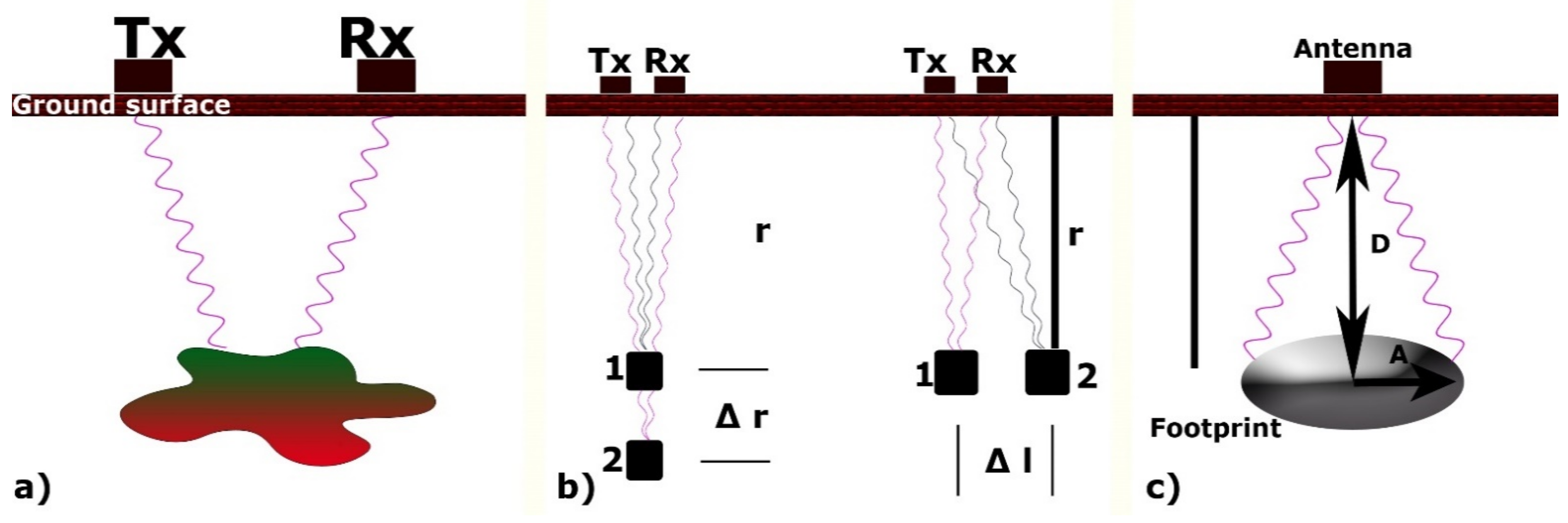
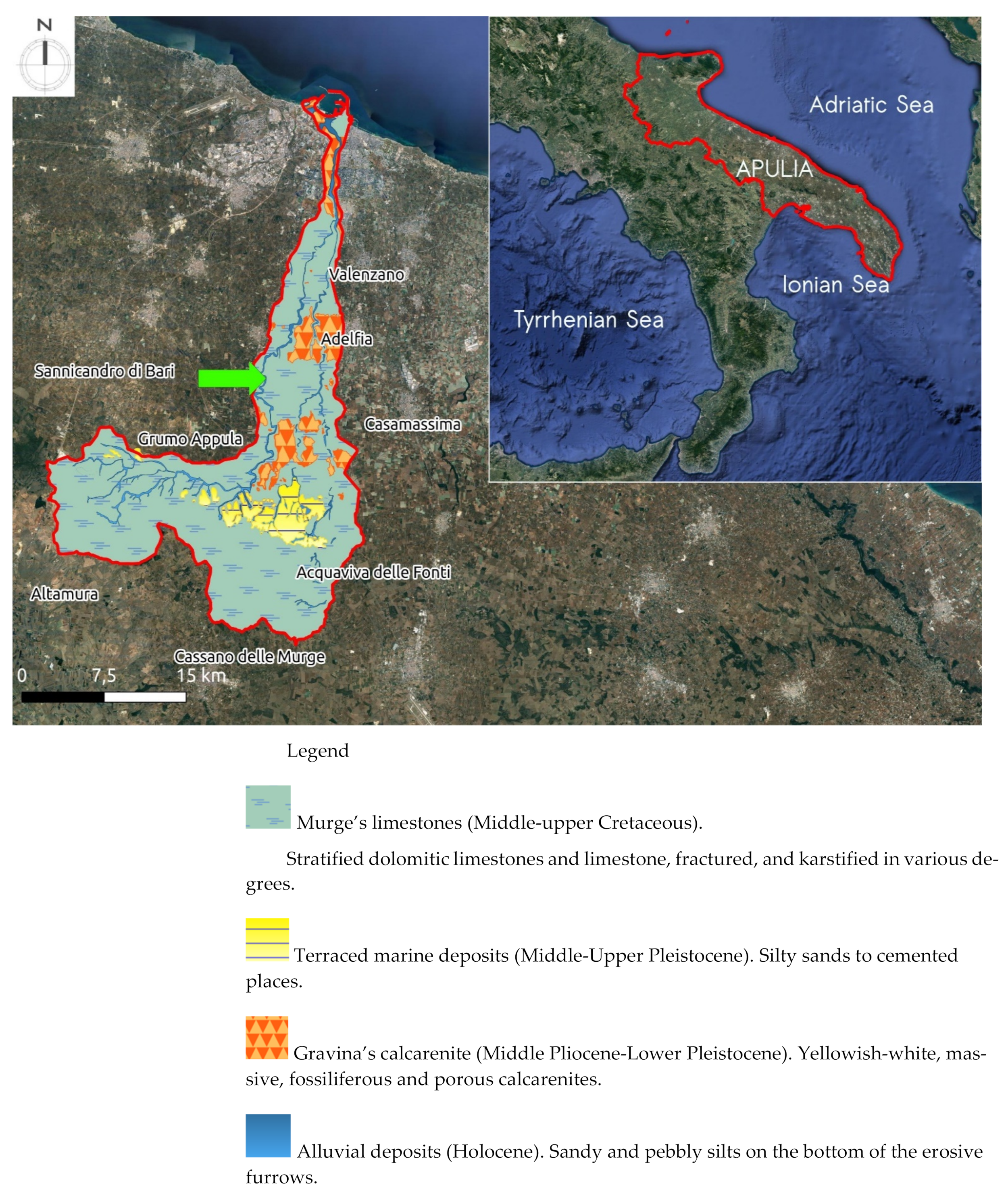

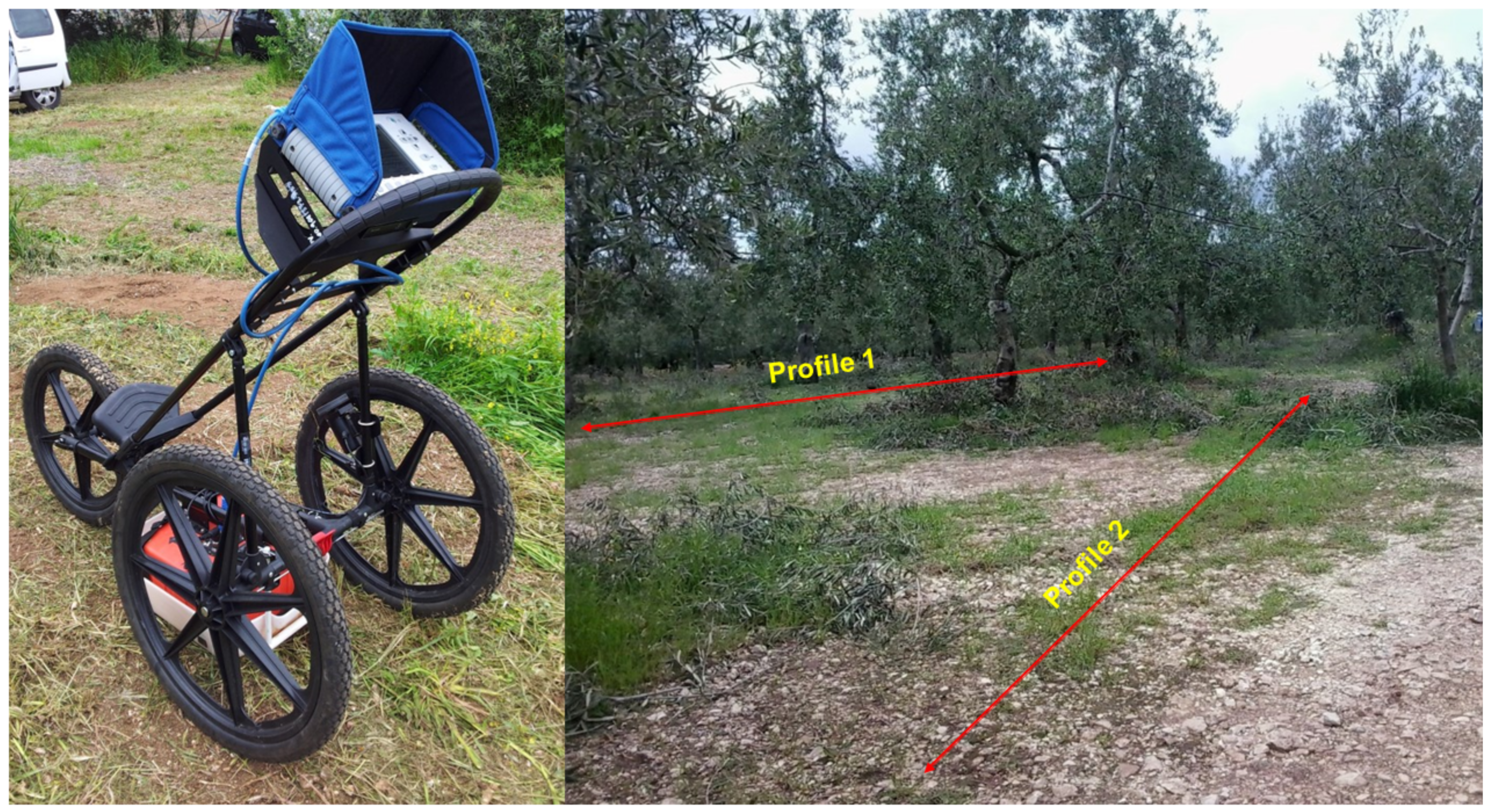
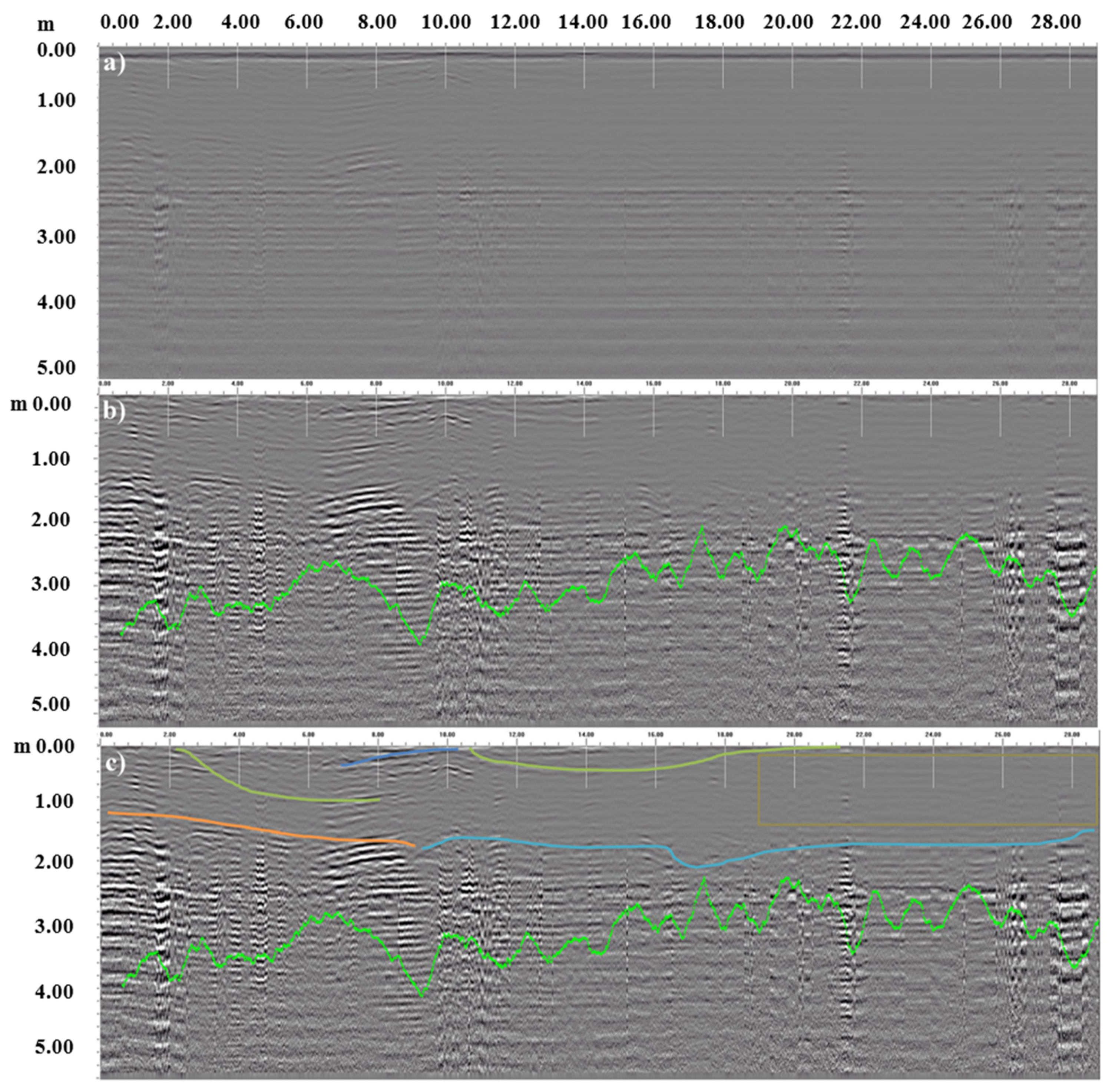
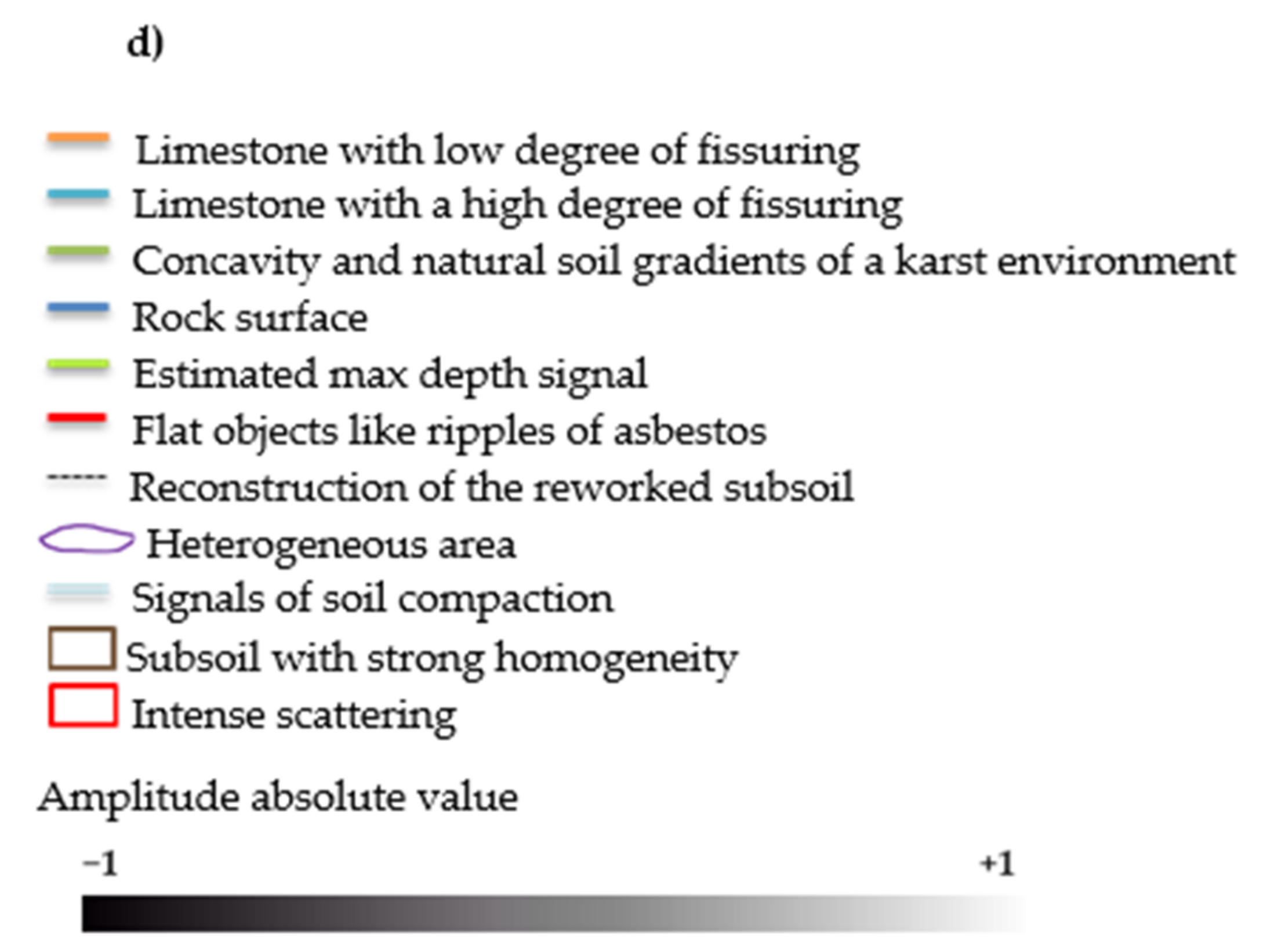
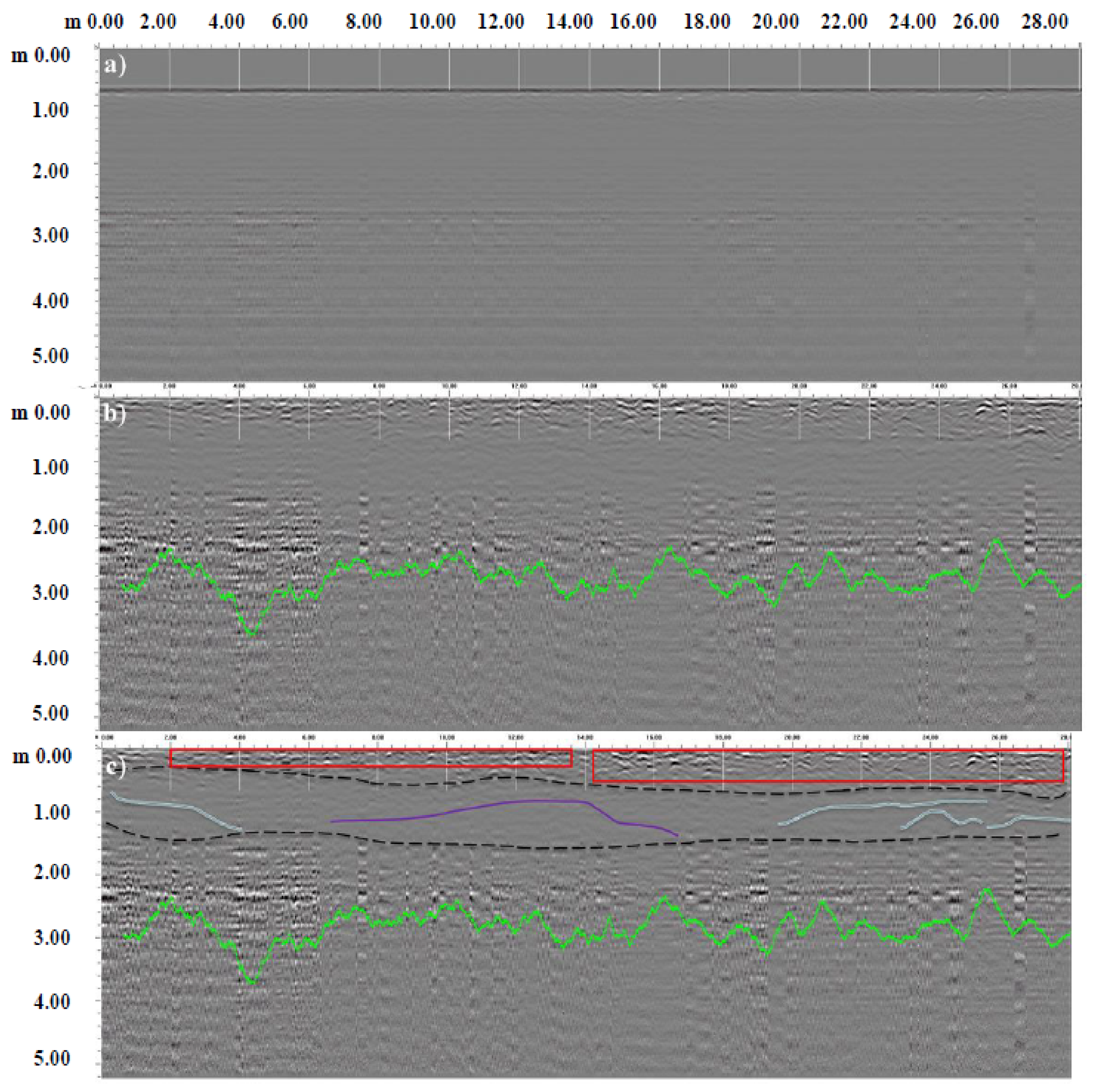
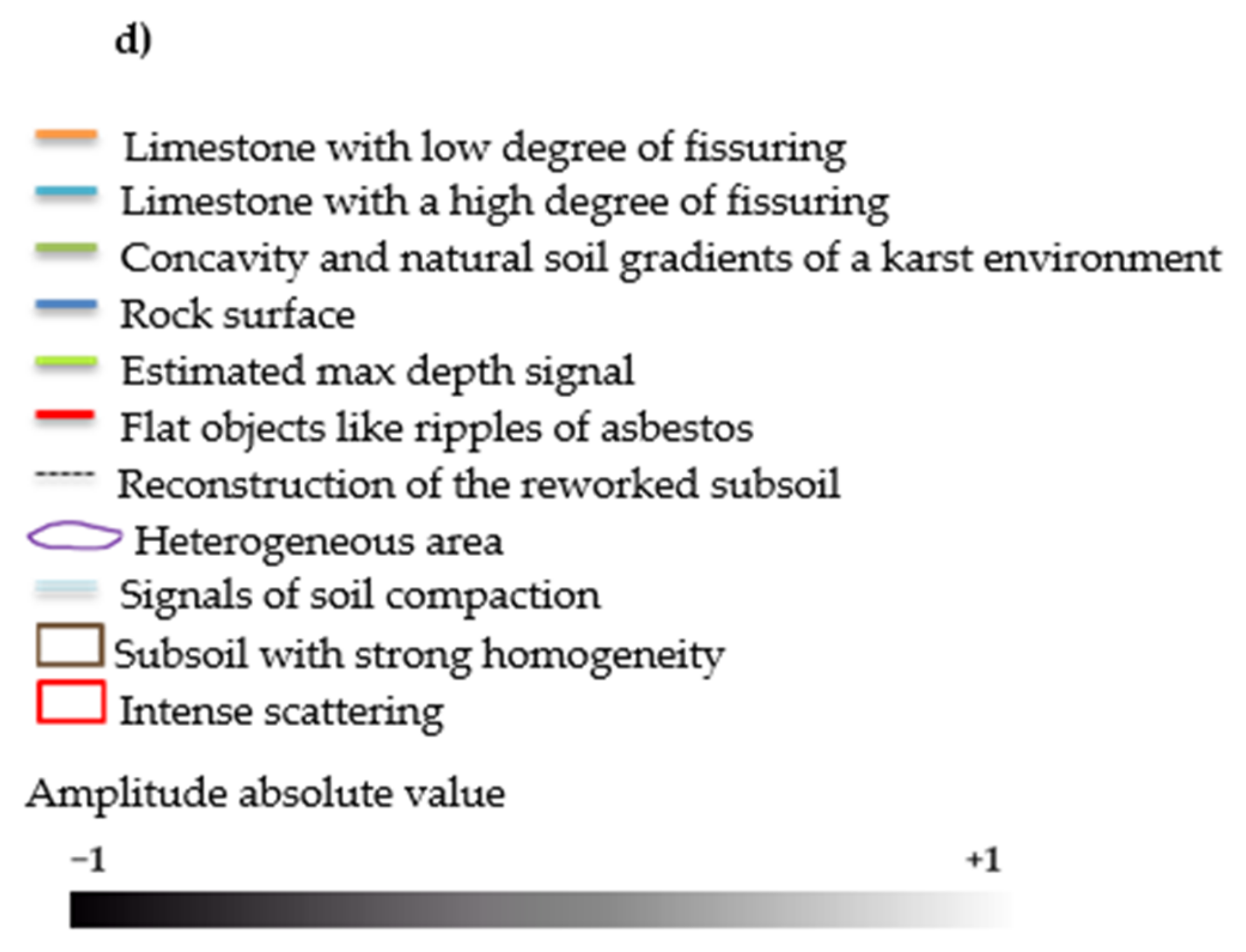
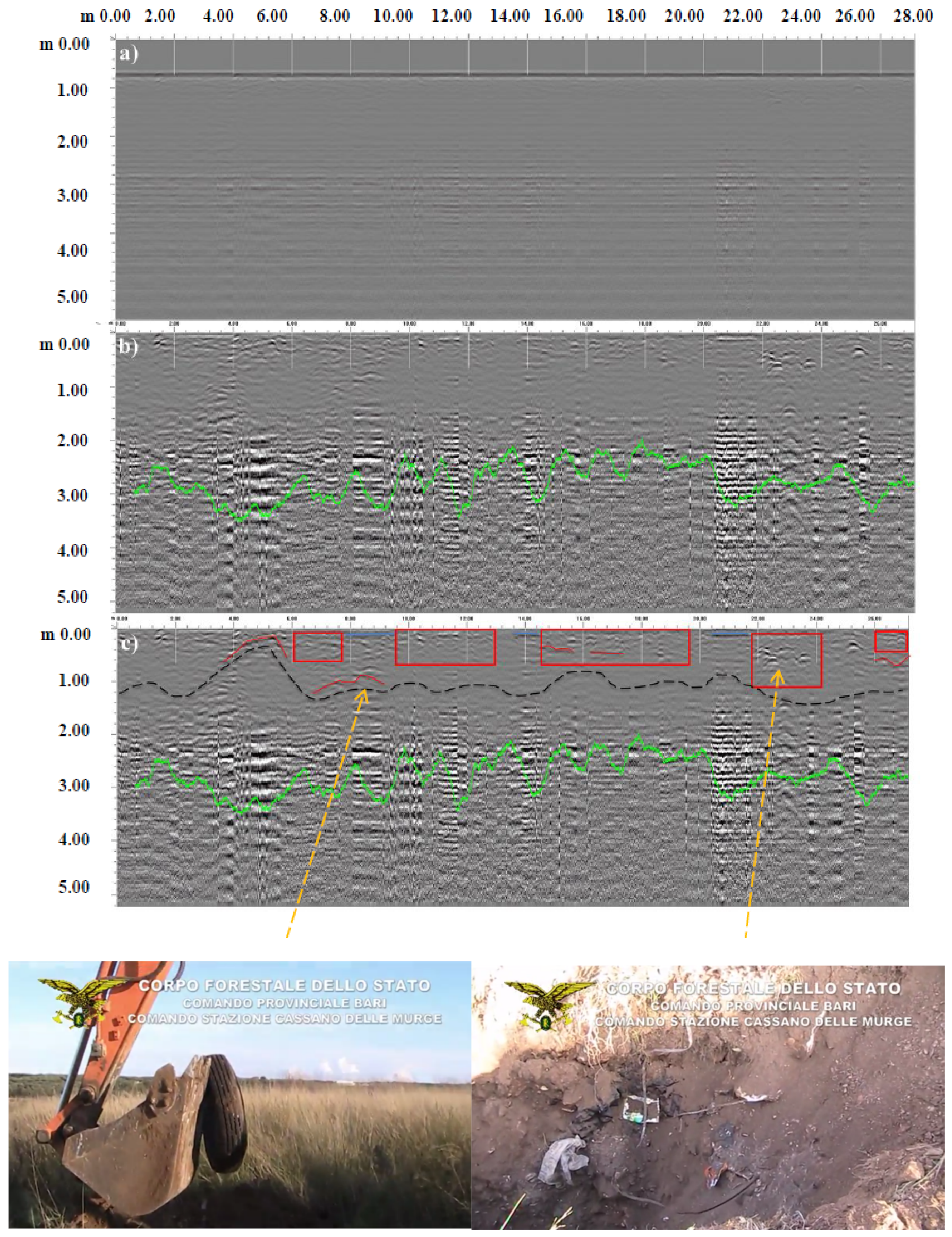
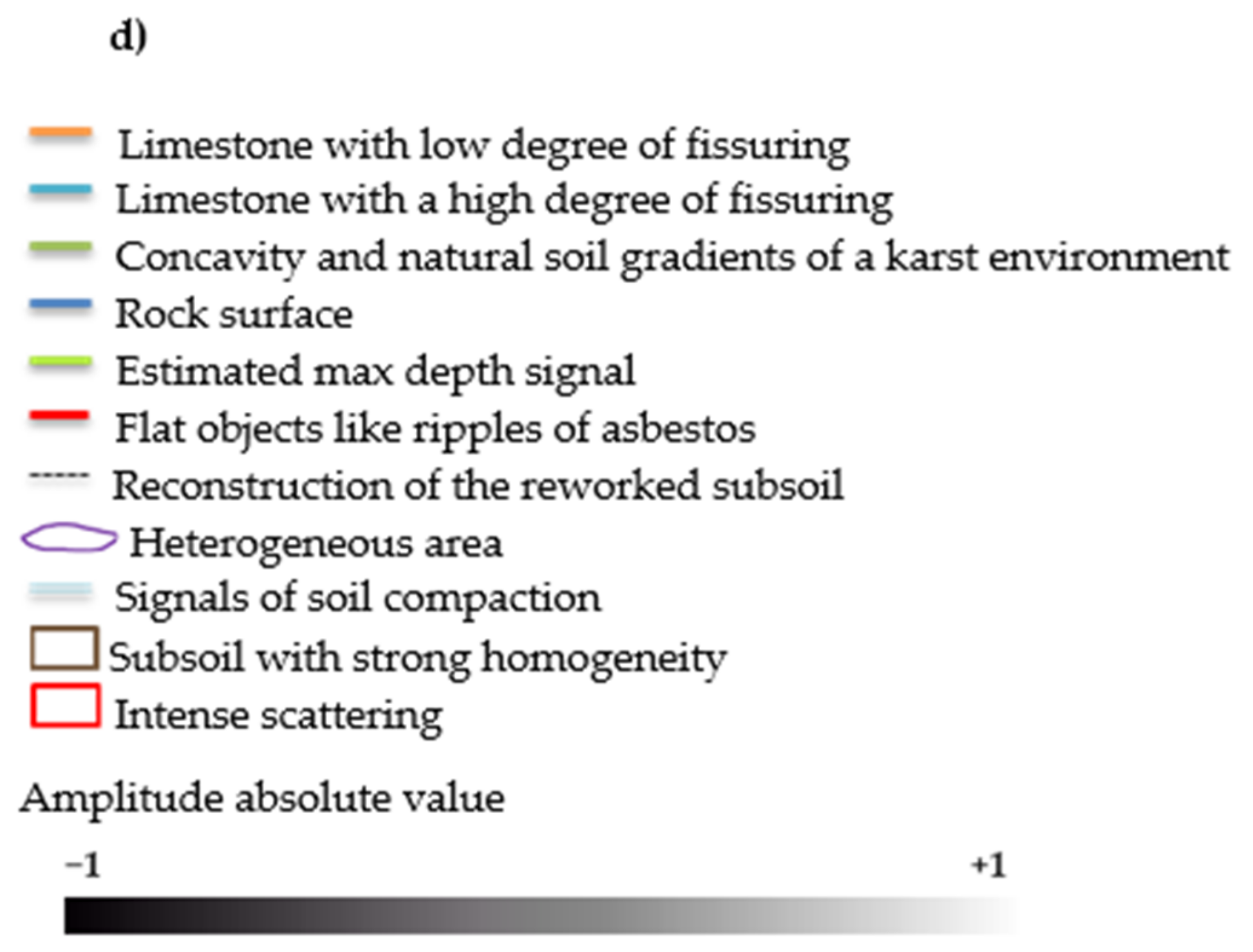
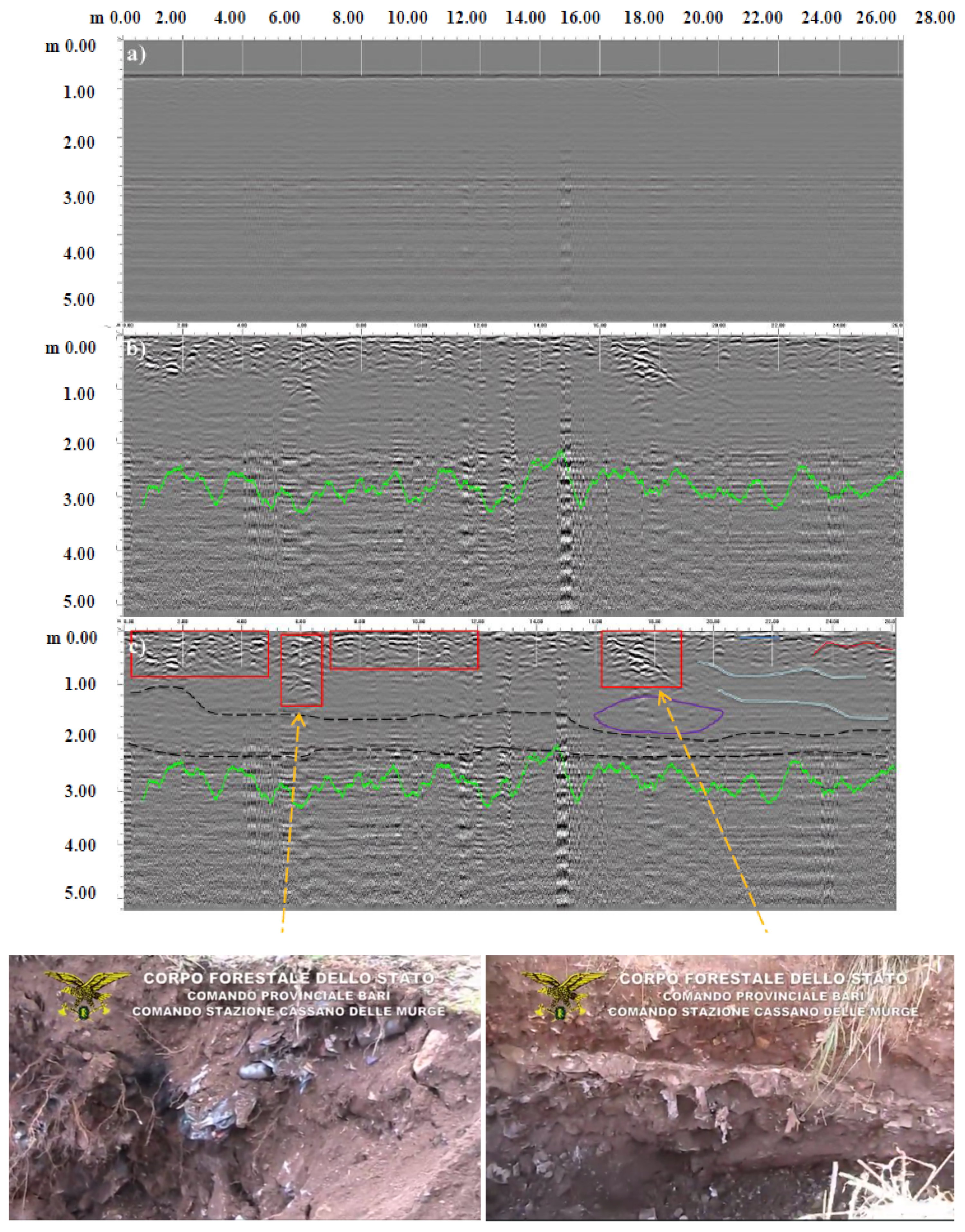
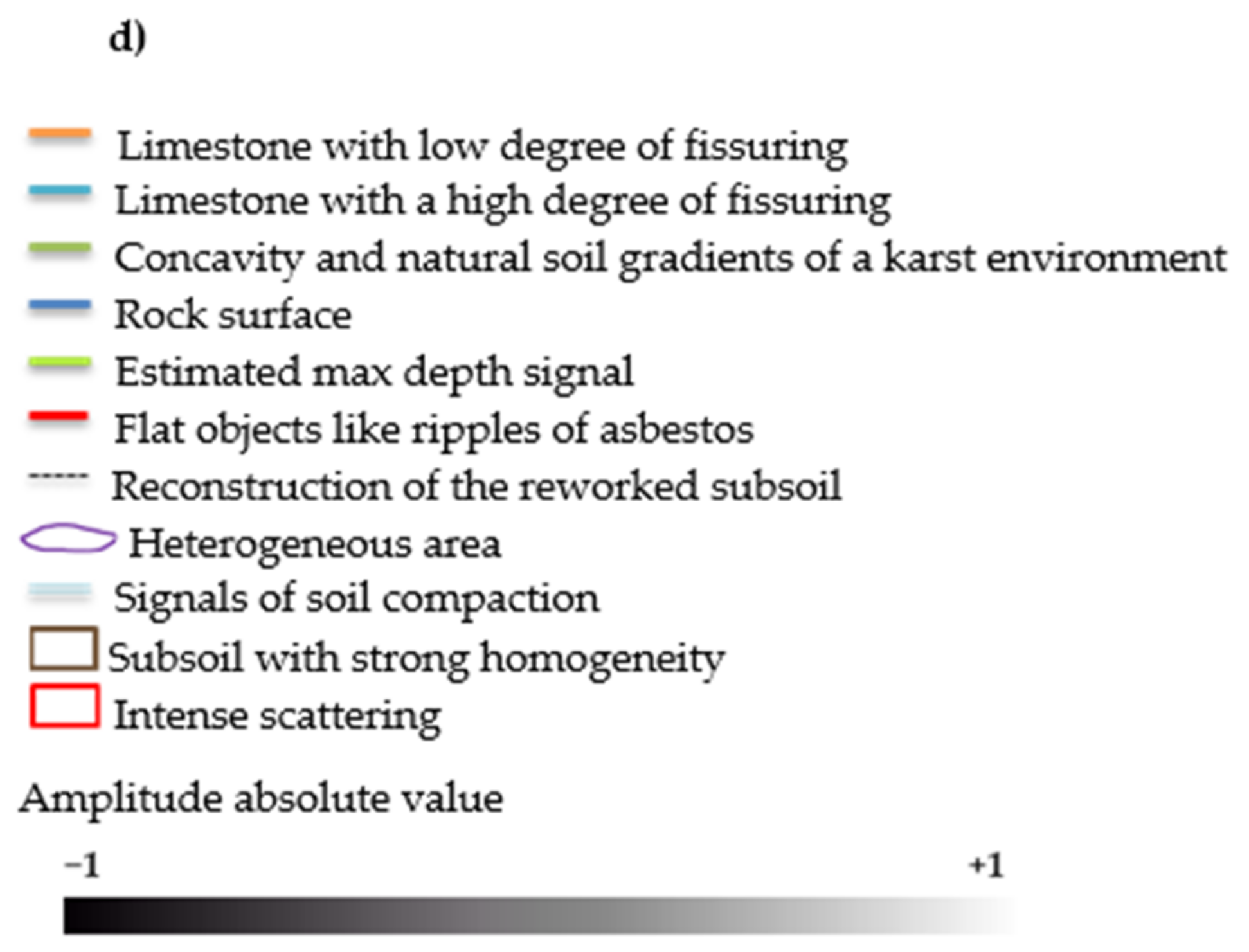
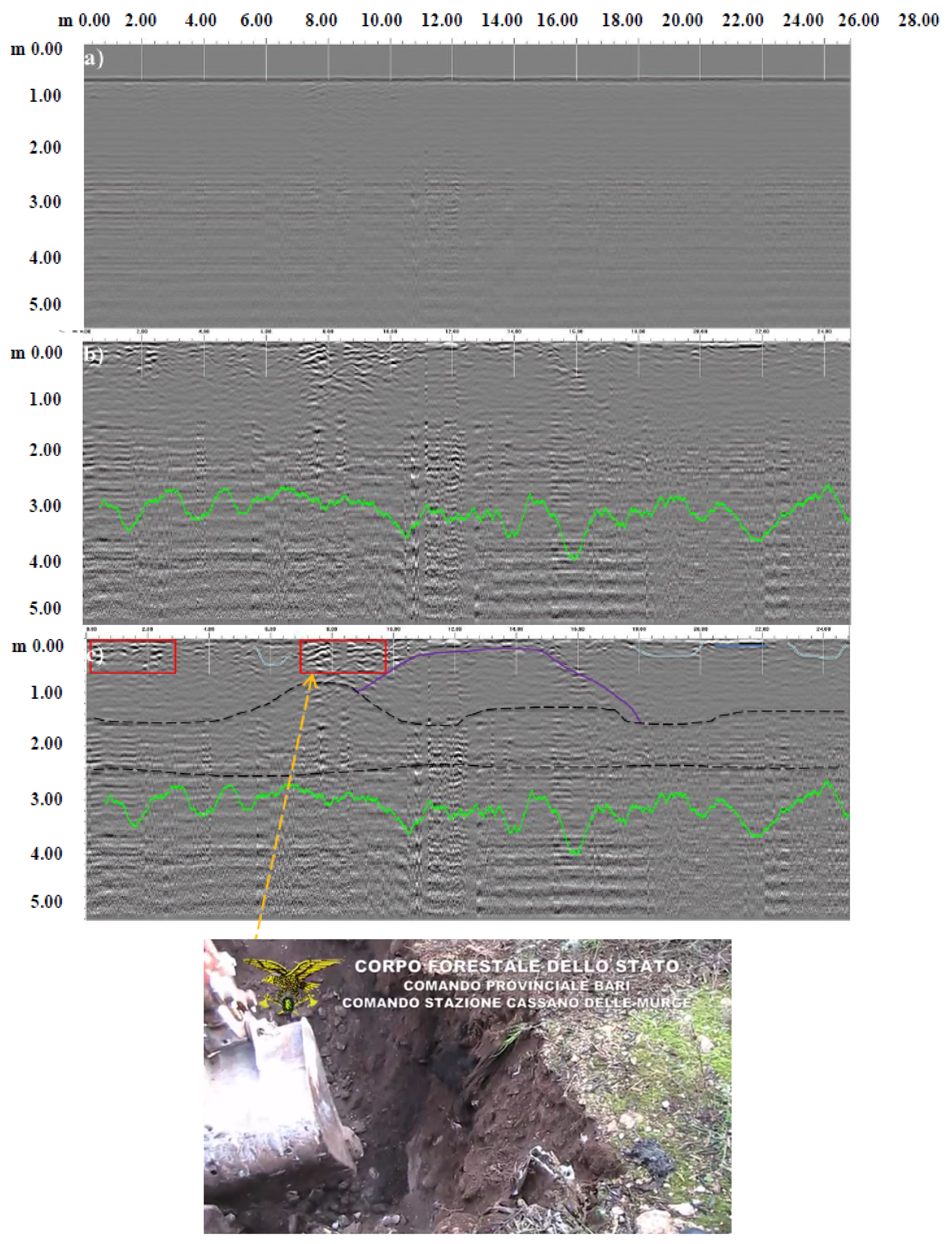
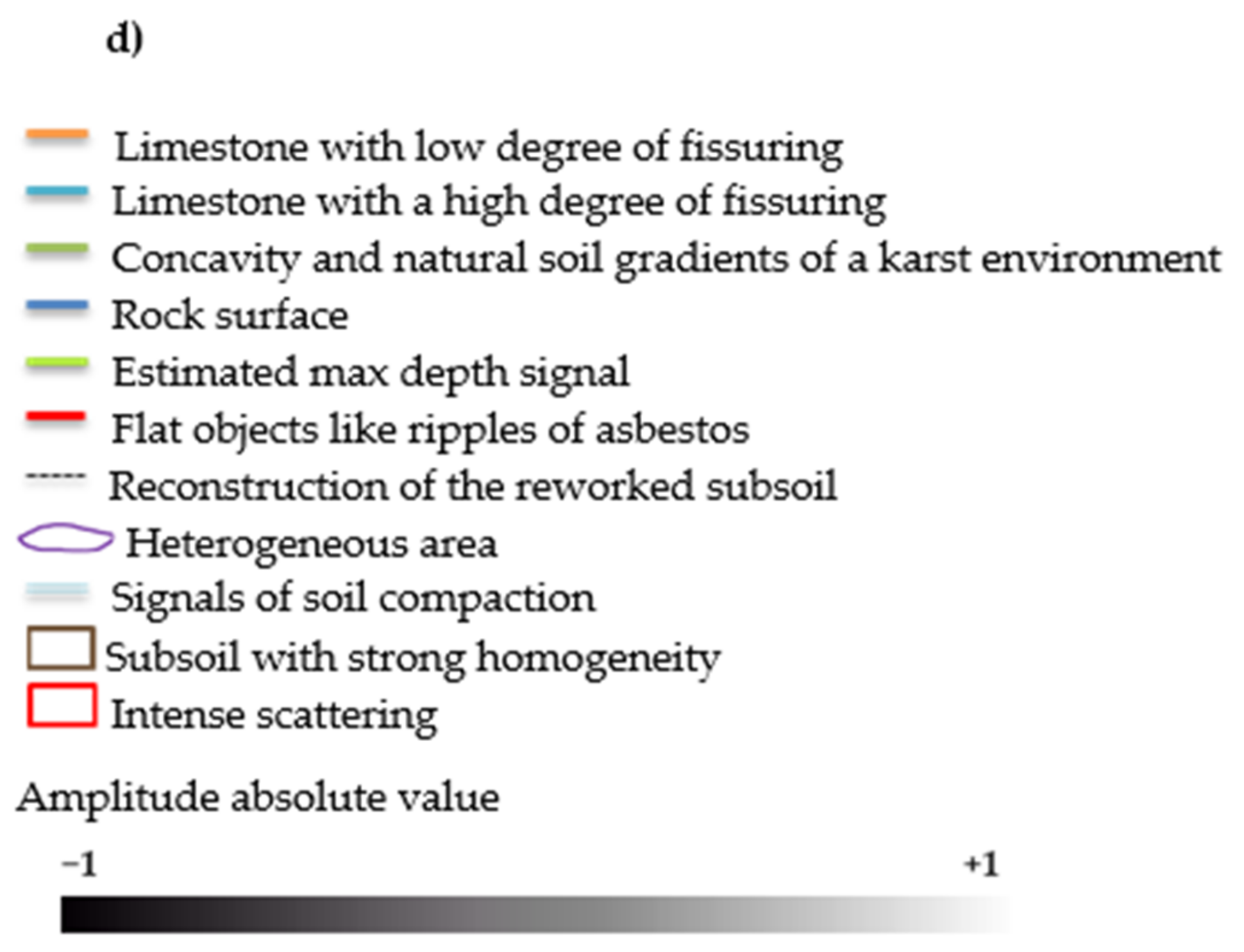
| Material | RDP | Wave Velocity (mm/ns) |
|---|---|---|
| Air | 1 | 300 |
| Dry sand | 3–5 | 120–173 |
| Clay soil (dry) | 3 | 173 |
| Asphalt | 3–5 | 134–173 |
| Quartz | 4.3 | 145 |
| Limestone | 4–8 | 100–113 |
| Granite | 5–15 | 106–120 |
| Concrete | 6 | 112 |
| Dolomite | 6.8–8 | 106–115 |
| Clay (wet) | 8–15 | 86–110 |
| Sandy soil | 10 | 95 |
| Pastoral land | 13 | 83 |
| Agricultural land | 15 | 77 |
| Freshwater | 80 | 35 |
| Seawater | >81 | 33 |
| f | RDP | λ | A_1 | A_2 | A_3 | A_5 |
|---|---|---|---|---|---|---|
| MHz | - | m | m | m | m | m |
| 400 | 1 | 0.75 | 0.89 | 1.60 | 2.31 | 3.72 |
| 5 | 0.34 | 0.49 | 0.90 | 1.31 | 2.13 | |
| 15 | 0.19 | 0.30 | 0.55 | 0.80 | 1.30 | |
| 25 | 0.15 | 0.23 | 0.43 | 0.63 | 1.02 |
Publisher’s Note: MDPI stays neutral with regard to jurisdictional claims in published maps and institutional affiliations. |
© 2021 by the authors. Licensee MDPI, Basel, Switzerland. This article is an open access article distributed under the terms and conditions of the Creative Commons Attribution (CC BY) license (https://creativecommons.org/licenses/by/4.0/).
Share and Cite
Massarelli, C.; Campanale, C.; Uricchio, V.F. Ground Penetrating Radar as a Functional Tool to Outline the Presence of Buried Waste: A Case Study in South Italy. Sustainability 2021, 13, 3805. https://doi.org/10.3390/su13073805
Massarelli C, Campanale C, Uricchio VF. Ground Penetrating Radar as a Functional Tool to Outline the Presence of Buried Waste: A Case Study in South Italy. Sustainability. 2021; 13(7):3805. https://doi.org/10.3390/su13073805
Chicago/Turabian StyleMassarelli, Carmine, Claudia Campanale, and Vito Felice Uricchio. 2021. "Ground Penetrating Radar as a Functional Tool to Outline the Presence of Buried Waste: A Case Study in South Italy" Sustainability 13, no. 7: 3805. https://doi.org/10.3390/su13073805








